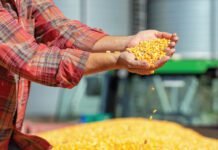Producing over 20 million tonnes of paddy straw every year, most of which is burnt in fields by farmers, leading to widespread air pollution that even spreads to neighbouring states, Punjab has now proposed to use the paddy crop residue as fodder for animals, especially cattle.
Basis upon which Punjab government made the proposal
A research report prepared by the state’s only vet varsity — Guru Angad Dev Veterinary and Animal Sciences University (GADVASU), Ludhiana — was submitted to the government under the project ‘Preparation for the control of stubble burning during Kharif season 2021’, which has recommended usage of paddy straw as animal feed. The report says that “nearly 30.4 per cent of rice straw is used for animal feed in Southeast Asia, Mongolia and China”.
It adds: “In Punjab, the total availability of paddy straw is about 20 million tones per annum. The total value of this straw is Rs 400 crore approx, calculated on an average rate of Rs 200/quintal. Almost all of it is burnt in fields. This accounts for economic loss apart from the loss of 77,000 tonnes of nitrogen and 5.6 million tonnes of Total Digestible Nutrients (TDN) which could be used for ruminant production.”
As per the report, the nutritional value of 20 million tonnes of paddy straw is: 10 lakh tonnes of crude protein (CP), 3 lakh tonnes of digestible crude protein (DCP), 80 lakh tonnes of total digestible nutrients (TDN) and phosphorous. It also highlights that “the requirement of feed and fodder for ruminants at national level is in deficit. The situation will get worse in terms of availability of both green and dry fodder during coming years.”
According to GADVASU experts, Animals cannot be fed paddy straw directly from fields. “High silica and lignin content reduces its digestive properties. Higher selenium content in paddy straw also limits its use as fodder in animals as compared to wheat straw. However, if given in moderate quantities (up to 5 kg per animal per day), selenium poses no health hazard to the animal.”
“Paddy straw also contains oxalates (2-2.5%) which leads to calcium deficiency so mineral mixture should always be fed along with the straw,” said Ravinder Singh Grewal, director, livestock farms, GADVASU.
Treatments recommended by GADVASU
There are two methods that have been recommended in the report submitted by GADVASU: Urea-only treatment and urea plus molasses treatment for paddy straw before using it as cattle fodder.
Urea Treatment
“Urea treatment of paddy straw has a vast potential to improve animal productivity for rice straw,” says the report.
The urea treatment procedure developed by the university says: “Dissolve 14 kg urea in 200 litres water and spray on chopped paddy straw, mix thoroughly and stack it for 9 days. After 9 days, stack can be opened from one side. The fermented straws have soft texture with 6.0-8.0 per cent crude protein, 3.0-4.0 per cent DCP and 55-60 per cent TDN. This involves a combination of physical, chemical and biological treatments. The paddy straw is chaffed and moistened (physical) with urea solution (chemical), the breakdown of urea release ammonia gas, a part of which is utilised by microbes (biological) for their proliferation (enriching the straw with microbial protein), resulting in rise of stack temperature, which facilitates the penetration of ammonia in the cell wall, resulting in breakage of lingo-cellulosic bonds making cellulose and hemi-cellulose assessable for utilization by microbes in the rumen. The digestibility of cellulose increases from 40-45% in untreated paddy straw to 70-75 per cent in fermented wheat straw.”
Nutritional value of paddy straw after urea treatment
The figures given by the varsity in its report shows that CP, DCP and TDN values in urea treated paddy straw increased manifold as compared to untreated straw. Crude protein (CP) increased from 4.5% to 8%, digestible crude protein (DCP) from 1.5% to 4% and total digestible nutrients (TDN) from 40% to 55%.
‘The feeding of urea treated straw (6 kg/day) to lactating buffaloes giving about 10 kg milk/day can result in saving about 60 per cent of oilseed cake in the ration. Feeding of paddy straw should be mixed with berseem, cowpea or Lucerne as it forms a maintenance ration. The straw should be fed with concentrate mixture and additional DCP or limestone should be given to the animals to reduce the effect of oxalates. Oxalates also interfere in carbohydrate metabolism perhaps due to non-availability of calcium as cofactor,” says the report
Urea plus molasses treatment
Also called “Urea-Molasses impregnated straw”, this method involves treating paddy straw with urea and molasses. “Urea 1 kg and molasses 3 kg was mixed thoroughly and mixed with water 10 kg. This is mixed with chaffed paddy straw and fed to animals on same day. This treated straw alongwith mineral mixture and salt makes up a maintenance ration for non-producing animals,” says the report.
The experts however clarify that for maintenance of body weight in animals, paddy straw alone is not sufficient. “Minerals and green fodder supplementation are required,” the report adds.
Potential harmful effects untreated straw
The report mentions: “The intake of siliceous forages has been associated with urinary siliceous calculi in drier regions where water may be limited. There have been no definitive studies in India, but urinary calculi are associated with rice straw consumption. Urinary calculi are commonly formed in sheep and cattle…Rice straw also differs from other straws in having a high (1–2 per cent) content of oxalates. These are broken down in the rumen to carbonates and bicarbonates, absorbed, and then excreted in the urine. The pH of water extracts of rice straw is about 8 and that of urine from stock-fed rice straw as high as 9. The high oxalate content has been implicated in the greater need for calcium supplementation. It has high selenium (0.5 to 4.5 %) content which can cause serious health problems in dairy animals.”
Source: Indian Express













